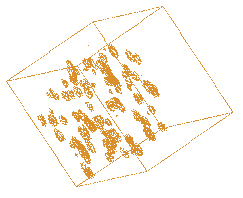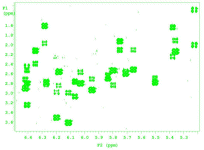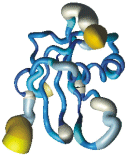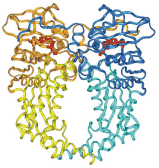The research objectives where NMR spectroscopy can be used as a method of choice are centred around the following Work Packages:
Conformationaly restricted nucleosides - 1H, 13C and 15N NMR Study (WP1)
Partners involved:
Prof. J. Plavec, NMR centre, NIC, Ljubljana, Slovenia
Prof. B. Golankiewicz, D. Baranowski, Institute of Bioorganic Chemistry, Polish Academy of Sciences, Poznan, Poland
WP1 is focused on characterization of conformational properties of intramolecularly cyclized nucleosides with restricted conformation of the sugar moiety as promising candidates for high binding affinities with complementary RNA and DNA fragments.

Deuterium NMR as a tool for studying carbohydrate metabolism in man (WP2)
Partners involved:
Prof. J. Plavec, NMR centre, NIC, Ljubljana, Slovenia Prof. E. Haslinger, Dr. E. Rosian, Dr. O. Kunert, Institute for Pharmaceutical Chemistry, University Graz, Graz, Austria
The main objective of WP2 is to develop method based on 2H NMR, which will enable the study of metabolism of carbohydrates and determine the fractional contribution of gluconeogenesis in endogenous glucose production and to understand the pathogenesis of fasting hyperglycemia occurring in type II diabetes mellitus.

Complex enzymatic reactions (WP3)
Partners involved:
Prof. J. Plavec, Dr. M. Polak, NMR centre, NIC, Ljubljana, Slovenia Prof. W. Steiner, G. Straganz, T. Mandl, Institute for Biotechnology, Technical University Graz, Graz, Austria
We are investigating specific metabolic pathways of some individual enzymes and study aqueous solution structures of some unstable pathway intermediates, which is essential for understanding the mechanism and stereochemical courses of the enzymatic reactions.
Nucleic acid structure and conformation (WP4)
Partners involved:
Prof. J. Plavec, Dr. M. Polak, M. Crnugelj, M. Plevnik, P. Sket, NMR centre, NIC, Ljubljana, Slovenia Prof. J. Chattopadhyaya, Department of Bioorganic Chemistry, Uppsala University, Uppsala, Sweden Prof. R. Adamiak, Dr. Z. Gdaniec, Dr. M. Popenda, Dr. M. Olejniczak, Institute of Bioorganic Chemistry, Polish Academy of Sciences, Poznan, Poland Dr. I. Luyten, Leuven, Belgium Dr. C. Thibaudeau, France Prof. M. Potrzebowski, S. Olejnicyak, Centre for Molecular & Macromol. Studies, Polish Academy of Sciences, Lódz, Poland Prof. J. Radecki, Dr. H. Radecka, Analytical Chemistry Department, Polish Academy of Sciences, Olsztyn, Poland Dr. U. Schneider, Wurzburg, Germany Prof. V. Balevicius, Faculty of Physics, Vilnius University, Vilnius, Lithuania
Nucleic acids play a central role in biological processes of cell. The versatile roles of DNA and RNA are related with different structures that can differ from basic structural elements like B-form double helix for DNA and A-type helix for RNA.

Summer School (WP5)
Summer School on Biomolecular Structure and Dynamics, Advances in NMR and computational methods, June 2003, Novo mesto, Slovenia.
Metastable states and conformational transitions of proteins involved in disease (WP6)
Partners involved:
Prof. R. Jerala, I. Hafner, B. Japelj, NIC, Ljubljana, Slovenia Prof. J. P. Waltho, Dr. J. Craven, Dr. R. Staniforth, University of Sheffield, Sheffield, UK
Conformational changes of different proteins (e.g. TSE - PrP, Alzheimer disease - β-amyloid protein) can lead to diseases. NMR can be used to follow structural changes that are in many cases linked to the formation of dimers or aggregates.

NMR conference "Frontiers of Biomolecular NMR" (WP7)
Frontiers of Biomolecular NMR - Five Years of Slovenian NMR Centre, February 16-17, 2001, Slovenia
Theoretical and experimental studies of intramolecular hydrogen bonding (WP8)
Partners involved:
Dr. J. Mavri, Prof. D. Hadzi, Dr. G. Ambrozic, J. Stare, NIC, Ljubljana, Slovenia Prof. A. Koll, A. Jezierska, P. Rodzievicz, University of Wroclaw, Poland
The nature of medium strong intramolecular hydrogen bonds in various Mannich and Schiff bases is studied by measuring 13C and 1H NMR chemical shifts and comparing the results with ab initio or DFT GIAO calculated values.
Conformational analysis of peptidomimetic drugs (WP9)
Partners involved:
Dr. S. Golic Grdadolnik, NIC, Ljubljana, Slovenia Prof. T. Mavromoustakos, P. Zoumpoulakis, I. Kyrkoy, National Hellenic Research Foundation, Athens, Greece
WP9 focuses on the conformational analysis of peptidomimetic drugs that act directly on AT1 receptors of Angiotensin II. The knowledge of a bioactive conformation provides the basis for rational design of new antihypertensive drugs.
Drug-membrane interactions (WP10)
Partners involved:
Dr. S. Golic Grdadolnik, NIC, Ljubljana, Slovenia Prof. H. Kessler, Institute for Organic Chemistry and Biochemistry, Technical University München, Germany Prof. G. Gemmecker, Dr. R. Haessner, Institute for Organic Chemistry and Biochemistry, Technical University München, Germany
The project focuses on the conformational analysis and interaction of glycopeptide antibiotics at membrane level. Comprehensive understanding of mechanism of action of antibiotics at membrane level will lead to the understanding of physical chemical parameters, which determine their modes of action.

Drug discovery from natural products (WP11)
Partners involved:
Dr. I. Vovk, Dr. B. Simonovska, S. Andrensek, Laboratory for Food Chemistry, NIC, Ljubljana, Slovenia Prof. H. Vuorela, Prof. R. Hiltunen, Dr. P. Vuorela, T. Yrjönen, University of Helsinki, Department of Pharmacy, Helsinki, Finland
Triterpenoids and flavonoids are among most spread plant secondary metabolites and show many interesting biological activities (anti-cancer, anti-inflammatory, prevention of liver injury etc).
|
